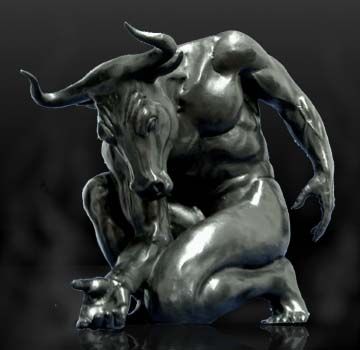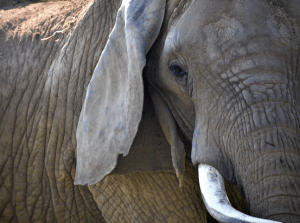When people talk about the ancient mythological creature Minotaur, a ferocious beast immediately comes to mind and perhaps the infamous myth of the labyrinth as well. What people may not know, though, are the interesting details of the events that lead up to the birth of the mighty Minotaur. What is universally recognized as a feared creature of unusual birth was actually created from unfortunate actions between a selfish king and a vengeful god.
King Minos and his wife Queen Pasiphae led a good life ruling over the island of Crete. Minos held power over multiple islands of Greece and was recognized for his success and power by many. In an attempt to prove his rightful claim as King of Crete, Minos had sworn to locate the best bull he could find among his cattle, one that would be very favorable to its intended receiver. Minos would then take this great bull and sacrifice it to Poseidon, god of the seas, as he did each year in order to secure his ownership of the throne. One year in particular, among King Minos’ herd, there birthed a magnificent bull, one that possessed a unique kind of beauty that King Minos had never seen before. Minos truly was in awe of this magnificent bull, so much so that he found himself captivated by its beauty, and he realized that this bull was something he did not want to give up to the promised Poseidon. In fact, Minos purposefully chose to overlook the magnificent bull when making his decision, and settled on a less attractive bull to sacrifice to Poseidon.1

Watching him and his deceitful actions very closely, Poseidon took notice of King Minos’ plan in sacrificing a lesser bull to keep the best for himself. This made Poseidon very angry, and he immediately began thinking about how to discipline Minos for his selfishness. Poseidon saw that Minos loved his wife Pasiphae immensely, and with this knowledge, constructed a plan that would leave Minos and Pasiphae in the presence of a monster. 2
Poseidon cast a curse upon Queen Pasiphae, one of love, which she could not escape. Her love was not for her husband; instead, she felt love for his magnificent bull. Pasiphae would be found swooning over the magnificent bull as if it were a handsome and powerful man ready to take her into his strong arms. Alas, she was so utterly infatuated with the magnificent bull that she constructed a plan to lure the bull towards her, and hopefully lay with her romantically.3
Queen Pasiphae instructed a craftsman of the island, Daedalus, and his son, Icarus, to build her a wooden structure that represented a near-perfect body form of a female bull. She insisted that the piece be built as realistically as possible and large enough for herself to comfortably fit inside without revealing that she was human. In spite of her odd orders, Daedalus and Icarus did what the Queen asked of them. As a finishing touch, Queen Pasiphae placed a large cow hide over the structure so that the magnificent bull would notice the structure and take it as a female looking to mate. The Queen rolled the structure out to the field where she would often see the magnificent bull grazing day after day. She strategically placed herself in the view of the magnificent bull, stepped inside the structure, and waited patiently for the bull’s approach.4

After grazing for a bit, the magnificent bull caught sight of what it thought was the beautiful female and approached it. Before long, the Queen’s plan worked, as the magnificent bull fastened itself upon her and together, engaged in sexual and intimate relations. As a result of this, Queen Pasiphae became pregnant with the baby of the bull and upon its birth realized she was carrying something horrific inside of her.5
Just as Poseidon intended, Pasiphae had relations with the bull she loved and later birthed an unusual creature, born half-bull, half-human to be known as the Minotaur.

The creation and birth of the Minotaur, as well as other monsters, typically is done in response to acts of sin. In this particular case, King Minos’ egotistical actions led him to break a promise made to a god, and in return, that god made Minos’ wife feel the same love that her husband did for the magnificent bull, giving in to her abnormal fascination and eventually birthing an infamous monster of ancient Greece.6
- UXL Encyclopedia of World Mythology, 2009, s.v. “Minotaur.” ↵
- UXL Encyclopedia of World Mythology, 2009, s.v. “Minotaur.” ↵
- Christian Moevs, “Centaurs, Spiders and Saints,” in Vertical Readings in Dante’s Comedy: Volume 2, edited by Corbett George and Webb Heather (Cambridge, UK: Open Book Publishers, 2016), 14-17. http://www.jstor.org/stable/j.ctt1sq5vb5.7. ↵
- UXL Encyclopedia of World Mythology, 2009, s.v. “Minotaur.” ↵
- Christian Moevs, “Centaurs, Spiders and Saints,” in Vertical Readings in Dante’s Comedy: Volume 2, edited by Corbett George and Webb Heather (Cambridge, UK: Open Book Publishers, 2016), 14-17. http://www.jstor.org/stable/j.ctt1sq5vb5.7. ↵
- George Palmer Garrett, “The Function of the Pasiphae Myth in Brother to Dragons,” Modern Language Notes 74, no. 4 (1959): 311-13. doi:10.2307/3040070. ↵



134 comments
Yadira Chavez
I loved reading this story. Greek mythology finds a way to catch the attention of almost everyone, the story telling is so unique and detailed. As a child I would always find books to read that centered on marvelous universes that had Gods and magical beings of good and bad, such as the Minotaur. In my head, I have always painted Poseidon in a positive light, that is until this story. It is really strange how he chose to punish King Minos, but that’s the Greeks for you.
Lorenzo Rivera
This article was extremely interesting and well written. The Minotaur is an extremely interesting creature, and it was nice to be able to read about its origins, and how it came to be. Greek Mythology is an extremely interesting topic to learn about, and learning about various aspects of it individually aid in seeing the bigger picture as a whole. Overall, great storytelling and descriptive messages by the author.
Kathyleen Lauriano
Ive heard of the Minotaur but never where it originated from. Its fascinating to read how it stared, and all because Minos wanted the bull for himself. The fact that Poseidon put such an unusual curse on Pasiphae is weird. Now people would think that falling in love with a bull is crazy, especially trying to be intimate with it. Its a weird story but a good read.
Nathan Alba
I always found the Minotaur quite interesting. However I did not know it’s exact origins. The article was a good read, but honestly nothing that I expected. It does convey a good message, because of King Minos being unable to keep his word that he promised to Poseidon, Minos would go on to pay for his mistake, even if it was to live through his wife having relations with a bull and giving birth to it’s offspring.
Nathalie Herrera
I have never heard the story of the creation of the Minotaur. It was interesting to read that Poseidon was responsible for this creation because King Minos did not sacrifice the best bull to him, thus making his wife fall in love with the bull King Minos hid away from Poseidon. The greek legends or myths have always grasped my attention immediately because of its powerful storytelling, and I think this article also provides this engagement to all readers.
Alexandra Lujan
I knew the Minotaur was an ancient Greek Myth, but I never understood the full story, Poseidon wanted revenge, and that’s what he did. I can’t help but wonder if the queen still loved her child because it was still hers but it will be seen as a monster in the world. Overall a great article about the creation of the Minotaur.
Antoinette Johnson
Spite and deception are two feelings that lead to the most trouble in the world. King Mino’s deceit lead to Poseidon’s spite of making his Mino’s wife fall in love with his prize bull. I feel that Poseidon should have directed his spite directly on to Mino. Pasiphae did not wrong, but she has to experience all the consequences of her husband’s actions. She has to raise a child that will be seen as a monstrosity to the world and she doesn’t know how Mino will feel about her affair and what he will do to her and her child. She did absolutely nothing, but are facing all the retribution of Mino’s deceit of Poseidon.
Christopher Vasquez
I was unaware of the origins of the Minotaur. Originally, I thought it was created through a divine presence, like Zeus, actually creating it; I had no idea that it was through the relations of a human and a bull. Although the idea of sin and punishment is present in many different religions, I find the different way in which they are portrayed to be interesting. Poseidon, instead of directly punishing Minos, he corrupted his wife and future, since now he has a problem: the Minotaur. I also wonder if Daedelus had figured out what Pasiphae intended to use the fake bull for. Although this story is a myth, it is still sad. I hope that Minos is able to properly reconcile with Poseidon.
Mariah Garcia
The Minotaur is an ancient Greek myth that I have heard about but didn’t know the full story. It was a very interesting yet odd story of such revenge from the god, Poseidon. Was the king aware of the curse that Poseidon had put upon the Queen? Did she love her child, the Minotaur, after she gave birth? Overall, it was a great article to read since Greek mythology is known yet some stories are left to be taught.
Lamont Traylor
I like this article because the Minotaur is such a mythical beast and it is so majestic. The first story I ever heard about this animal was of course the labyrinth, because that story is well known in Greek mythology. The beast is the guardian of the labyrinth and anyone who goes into it will wonder around until they run into it and get killed.